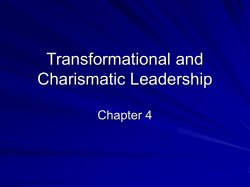
9 Leadership What is leadership?
9 Leadership Groups generally require guidance as they strive to reach their goals, and the individual who coordinates and motivates the group can fundamentally shape the group’s future. If asked, “What one thing would you change to turn an inept group into a productive one?” most people would answer, “The leader.” What is leadership? Who will emerge as a leader? Who do some lead and others follow? Why do some leaders succeed and others fail? The Nature of Leadership Leadership Emergence Theories of Leadership Emergence Leadership Effectiveness Leadership Myths Who Will Lead? Implicit Leadership Fiedler’s Contingency What is Leadership? Personality Social Identity Style Theories What Do Leaders Do? Competencies Social Role LMX Participation Terror Management Participation The Leader’s Look Evolutionary Transformational The Future of Leadership James MacGregor Burns writes: Leadership is “one of the most observed and least understood phenomena on earth” But much of the mystery of leadership evaporates when studied in terms of groups and their dynamics. Leadership Myths Leadership is power (with people rather than over people) Leaders are born (but leaders are also “made”) All groups have leaders (shared influence and group size) Leadership Myths People resist their leaders (most groups accept the need for a leader) Leaders make or break their groups (leaders influence their groups in significant ways) Leaders make ALL the difference (The “romance of leadership” exaggerates the impact of a leader What is Leadership? Leadership defined Guidance of others in their pursuits, often by organizing, directing, coordinating, supporting, and motivating their efforts. • Reciprocal (followership) • Transactional • Transformational • Cooperative • Adaptive, goal seeking What Do Leaders Do? The T-R Model THE LBDQ Researchers at Ohio State built these two dimensions into their Leader Behavior Description Questionnaire (LBDQ). The relationship between task-oriented leadership (structuring), relational leadership (support), and various leadership outcomes. Leadership Substitutes Theory What Do Leaders Do? Group Member Characteristics •Has ability, experience, training, knowledge • Has a need for independence • Has “professional orientation” • Is indifferent to group rewards Will Neutralize Task Leadership Task Characteristics •Is unambiguous and routine •Is methodologically invariant •Provides it own feedback concerning accomplishment •Is intrinsically satisfying Characteristics of the Organization •Formalized (explicit plans, goals, and areas of responsibility) •Inflexible (rigid, unbending rules and procedures) •Highly specified with active advisory and staff functions Will Neutralize Relationship Leadership • Closely knit, cohesive workgroups • Organizational rewards not within the leader’s control • Spatial distance between superior and subordinate What Do Leaders Do? Men: Task Leaders Men, Women, and Leadership Women: Relationship Leaders This difference between men and women is only a tendency; it does manifest itself across all group situations Assigns tasks to members Listens to group members Makes attitudes clear to the Easy to understand group Critical of poor work Sees to it that the group is working to capacity Coordinates activity Friendly and approachable Treats group members as equals Willing to make changes The Nature of Leadership Leadership Emergence Why Do Theories of Leadership Emergence Who Will Lead? Personality Competencies Thomas Carlyle’s Great Man Theory Some Lead and Leadership Others Follow? Effectiveness The history of the world is but the biography of great men. Participation The Leader’s Look Note: Except for Abraham Lincoln, who Tolstoy believed was a great man: “The greatness of Napoleon, Caesar or Washington is only moonlight by the sun of Lincoln. Zeitgeist Theory From War and Peace: The people of the west moved eastwards to slay their fellow men, and by the law of coincidence thousands of minute causes fitted in and coordinated to produce that movement and war: …A king is history's slave. Leo Tolstoy Personality Both Carlyle and Tolstoy were correct, but only when their views are combined: Leadership depends on the qualities of the individual, but also the nature of the situation. Traits + Situations = Leadership • The Interactional Model: Behavior is a function of the person and the environment (B = f (P, E) • A variety of personality factors are linked to leadership, including assertiveness, dominance, and character strengths (see Table 9.3) • Conscientiousness and Extraversion, in the Five Factor Model, are particularly strong predictors of leadership emergence. Personality Five Factor Model and Leadership Competencies Certain competencies are associated with leadership emergence. Groups prefer leaders who are somewhat more intelligent than the average group member. Emotional intelligence is related to leadership emergence and effectiveness. Sternberg’s systems model of leadership stresses the importance of practical and creative intelligence. Participation People who speak more in groups are likely to emerge as leaders (the babble effect), although work by Jones and Kelly suggests that quality of comments is more influential than sheer quantity. Quality Trumps Quantity Low Quality High Quality 5.73 4.73 3.72 Low Quantity 3.88 High Quantity The Leader’s Look Leadership is associated with demographic variables. • Leaders tend to be older, taller, and heavier than the average group member. • Ethnic minorities and women are less likely to be selected as leaders in groups. • Glass ceiling: hidden situational and interpersonal factors that prevent women from gaining leadership positions. • The bias against women is ironic because, in general, women possess more of the skills needed to be a successful leader. The Nature of Leadership Leadership Emergence Theories of Leadership LeadershipImplicit Leadership Effectiveness Emergence Theory (ILTs) Implicit Leadership Social Identity Social Role Terror Management Evolutionary Lord’s implicit leadership theory: Followers’ beliefs about what qualities they expect in a leader—their implicit leadership theories—influence their perceptual and cognitive reactions to leaders and potential leaders. Implicit Leadership Theory (ILTs) The prototype matching hypothesis suggests that individuals prefer leaders who match their ILTs, but ILTs can distort members’ perceptions of and reactions to their leaders. The Prototype Matching Hypothesis GLOBE study of leadership Cross-cultural analyses of leadership Charismatic I: Visionary* Foresight Prepared Anticipatory Plans Ahead * Charismatic II: Inspirational* Enthusiastic Positive Morale Booster Motive Arouser Dynamic Administratively Competent Orderly Administrative Skilled Organized Good Administrator Diplomatic Diplomatic Worldly Win-win Problem solver Effective Bargainer Humane *Orientation Generous Compassionate Integrity * Honest Sincere Just Trustworthy Decisive * Willful Decisive Logical Intuitive Team I: Collaborative Team * Group-oriented Collaborative Loyal Consultative Team II: Team Integrator * Communicative Team Builder Informed Integrator Performance Oriented * Improvementoriented Performance-oriented Procedural Ritualistic Formal Habitual Procedural Social Identity Theory Social identity theory assumes that leaders must “fit in” with their group and shape the group’s identity. Leaders tend to be prototypical: They match the group’s identity. Effective leaders minimize qualities that set them apart from the group. Leaders must favor the ingroup over the outgroup. Leaders usually condemn (or at least show distain for) the outgroup. Effective leaders create or strengthen the group’s identity. Social Role Theory Agency (and autonomy) • Forceful • Task-focused • Makes Decisions Easily • Dominant • Individualistic • Ambitious Communal Cheerful Supportive Sympathetic Tender Sensitive to others needs • Understanding • • • • • As Eagly and others note, these two sides of leadership correspond to sex role expectances Mortality salience triggers a need for charismatic leaders Terror Management Theory Awareness of Morality • Humans are aware of their mortality Existential Anxiety • Morality Salience (MS) MS leads to • Self-esteem bolstering • Protection of worldview • Need for a group-centered leader Terror Management Theory Before evaluating these candidates, participants in the mortality-salience condition were reminded of their eventual demise. The task-oriented leader was the most favorably rated in both conditions . But the charismatic leader was rated more positive when mortality was salient. Evolutionary Basics • Survival of the fittest • Sexual selection Leaders are useful in social species • Leaders help followers survive, thrive • Tribes with leaders are more “fit” Results • People readily recognize leaders • Leadership is a resilient cultural feature • Leadership has rewards to offset costs Van Vugt & Spisak, 2008, suggest that the “instinct” to seek a male leader is tuned to the situation If women are thought to be superior to men at maintaining group harmony If men are thought to be better during conflict with other groups Then 1. Women will be preferred as leaders during times of intragroup competition (and conflict) 2. Men will be preferred if there is trouble with another group (intergroup) The Nature of Leadership Leadership Emergence Theories of Leadership Emergence Leadership effectiveness depends on (is “contingent on”) both the person and the situation Fred Fiedler’s contingency theory includes 1 “person” variable (leadership motivation, which is task vs. relational) and 3 situational variables (that combine to determine situational favorability) Fiedler measured task motivation with his wellknown “Least Preferred Co-worker Scale”. Think of a person with whom you can work least well. He or she may be someone you work with now or someone you knew in the past. This coworker does not have to be the person you like least but should be the person with whom you had the most difficulty in getting a job done. Leadership Effectiveness Fiedler’s Contingency Style Theories LMX Participation Transformational The Future of Leadership Fiedler’s Contingency Theory High LPC leaders most effective in “moderately” favorable situations Low LPC leaders most effective in very favorable or very unfavorable situations In moderate situations, the correlation between LPC and Effectiveness is POSITIVE In highly favorable or highly unfavorable situations, the correlation between LPC and Effectiveness is NEGATIVE Fiedler’s Contingency Theory Style Theories Leadership effectiveness depends on the leader’s “style”—some styles are more effective than others—and the match of style to situation is also important. Blake and Mouton’s “leadership grid” theory Style Theories Leadership effectiveness depends on the leader’s “style”—some styles are more effective than others—and the match of style to situation is also important. The situational leadership theory, proposed by Hersey and Blanchard, suggests that groups benefit from leadership that meshes with the developmental stage of the group. LMX: Leader Member Exchange Theory Leader–member exchange theory (LMX) focuses on the dyadic relationship linking the leader to each member of the group and notes that, in many cases, two subgroups of linkages exist (the inner group and the outer group). Groups with more inner-group members are more productive. A B Outer group Inner group Leader R C W X D Y E G F Z Participation Theories Shared Leadership • Co-leadership, collective leadership, and peer leadership, encourage member-centered leadership methods. “Group Climates” • Lewin, Lippitt, and White compared three types of “group climates”: autocratic, democratic, and laissez-faire. Laissez-faire leadership was ineffective compared to democratic and autocratic, with members preferring democratic. Kelly’s Followership Theory • Kelly identifies five types of followers: conformist, passive, pragmatic, alienated, and exemplary. Lewin, Lippitt, and White compared three types of “group climates”: autocratic, democratic, and laissez-faire. Transformational Leadership Theories Transformational theories of leadership examine how charismatic leaders promote change. Leader Follower Burns distinguished between transactional leaders and transformational leaders and suggested that the latter are able to elevate both themselves and their followers. Bass’s transactional-transformational distinction Transactional Leadership Leaders treat their relationships with followers as a transaction: define expectations and offer rewards, some sort of exchange Contingent rewards: if a follower produces the desired behavior, she will receive the contracted award (positive and negative) Transformational Leadership Idealized influence Inspirational motivation Intellectual stimulation Individualized consideration The Future of Leadership Women tend to adopt participative and transformational styles of leadership, whereas men are more likely to enact autocratic, laissezfaire, and transactional styles. Women’s skills are particularly well suited for organizations of the future, which will be less hierarchical and require a collaborative, shared approach to leadership. The Nature of Leadership Leadership Emergence Theories of Leadership Emergence Leadership Effectiveness Leadership Myths Who Will Lead? Implicit Leadership Fiedler’s Contingency What is Leadership? Personality Social Identity Style Theories What Do Leaders Do? Competencies Social Role LMX Participation Terror Management Participation The Leader’s Look Evolutionary Transformational The Future of Leadership
© Copyright 2025



















